Ecommerce loyalty programs: How to keep customers coming back for more

Ecommerce loyalty programs have boomed in recent years. Driven by an increasingly competitive landscape and a growing body of research on the power of loyalty, just about every online retailer now offers some form of loyalty program. So what are the different types of loyalty programs? Why does your ecommerce store need one? And how can you ensure your loyalty program succeeds?
Rewards programs. Brand relationships. Loyalty programs. Subscription commerce. Memberships. VIPs. Friends & family.
Whatever you call them, strategies to strengthen connections between brands and customers have boomed in recent years.
Over 90% of companies now offer some type of customer loyalty program. This includes everyone from McDonald’s to Samsung to adidas to Disney.
The prominence of loyalty programs should come as no surprise once you see the data. The statistics spell it out again and again. Customers love loyalty programs and spend more with brands when they’re part of one:
- 79% of consumers are part of at least one loyalty program
- Of these, 75% say they purchase more from these brands
- Top loyalty programs see a 15-25% annual revenue increase from customers who use them
In this article, we take a deep dive into ecommerce loyalty programs, rewards programs, memberships, and subscriptions. You’ll discover what they are, why your brand needs one, what customers want out of a loyalty program, key examples from across industries, and proven strategies to ensure your loyalty program succeeds.
Table of Contents

Ecommerce loyalty programs are a way of formalizing and strengthening relationships between brands and consumers. They aim to deepen brand trust, expand brand touchpoints, enable personalization, and nurture loyalty.
To achieve these benefits, loyalty programs typically offer rewards, discounts, and other exclusive benefits in exchange for repeat purchases, personal information, and/or recurring payments.
Loyalty programs for ecommerce come in three key types: the subscription, the rewards program, and the membership.
Ecommerce subscriptions (also known as subscription commerce) involve a company making recurring charges to customers for ongoing access to products, services, or benefits. Examples include Amazon Prime, Walmart+, and eBay Plus.
Retail subscriptions require the largest commitment from customers and offer the largest range of benefits out of the three types of ecommerce loyalty programs. This is because they’re the only type of loyalty program where customers must pay to play.
For this reason, retail subscriptions almost always include a free trial, where the brand will attempt to prove the value of the program to customers.
Free shipping is often the primary benefit of retail subscriptions. Customers who regularly shop with a retailer can save money by paying a fixed subscription amount rather than shipping costs with every purchase.
For example, if a customer shops on Amazon twice a month and spends $10 on shipping each time ($20), they’ll save $5 a month with a $15 Amazon Prime subscription—along with getting access to a host of other perks.
This creates a bang-for-your-buck mentality, also known as the sunk cost fallacy, where consumers feel they must shop regularly with Amazon to get their money’s worth. So even if Amazon loses money by offering free shipping, they recoup their losses through subscription fees, as well as the fact that 70% of customers are likely to spend more with the brand because of their subscription.
With 200+ million members worldwide, Amazon rakes in over $20 billion in annual revenue from Prime subscriptions. That’s in addition to the valuable data they’re collecting, and the intense loyalty they inspire among Prime members.
RELATED: 79 Staggering Statistics That Show the Power of Loyalty Programs

The loyalty rewards program model involves giving repeat customers special benefits and/or enabling them to accrue points and rewards through spending.
Rewards programs date back to the 1970s when airlines invented frequent flyers rewards. Almost 50 years later, the model has spread across industries, and many airlines’ rewards programs are worth more than the airlines themselves.
American Airlines’ AAdvantage program is worth over $20 billion—more than triple the valuation of the airline.
Ecommerce loyalty rewards programs—like frequent flyers programs—are free and deliver value for customers based on the amount they spend. Some rewards programs also let customers get points for things like filling out surveys, leaving reviews, sharing posts on social media, and providing personal information.
Adidas’ adiClub, for example, lets customers “level up” after spending their first $100, and gives them free access to adidas Running and Training apps, as well as a birthday gift. Customers can get extra points by filling out their personal info, leaving reviews, and participating in adidas events.
The incentive-based premise of rewards programs is simple: the more you spend, the more benefits you get.
65% of customers say they modify the amount they spend with brands to maximize rewards benefits. And another 66% say they modify which brands they shop with to maximize their benefits.
Examples of rewards programs include Starbucks Rewards, Booking.com’s Genius, FARFETCH Access, My Bath & Body Works Rewards, and adidas’ adiClub.

Ecommerce membership programs are like rewards programs, but don’t offer spending-based incentives. Instead, members simply sign up for a newsletter or download an app to gain access to exclusive benefits.
Memberships have the lowest bar of entry of the three types of loyalty programs. They’re more about offering small benefits in exchange for email addresses and other data, as well as building a large and loyal customer base.
Most big retailers that offer any kind of private sales or product drops have a membership base they reward with first notifications of sales or product drops, as well as the occasional birthday gift or promo code.
Examples of this include Nike Membership, SKIMS The List, Samsung Members, Dyson Owner Rewards, and the Gymshark Family.
RELATED: 13 Successful & Innovative Loyalty Program Examples
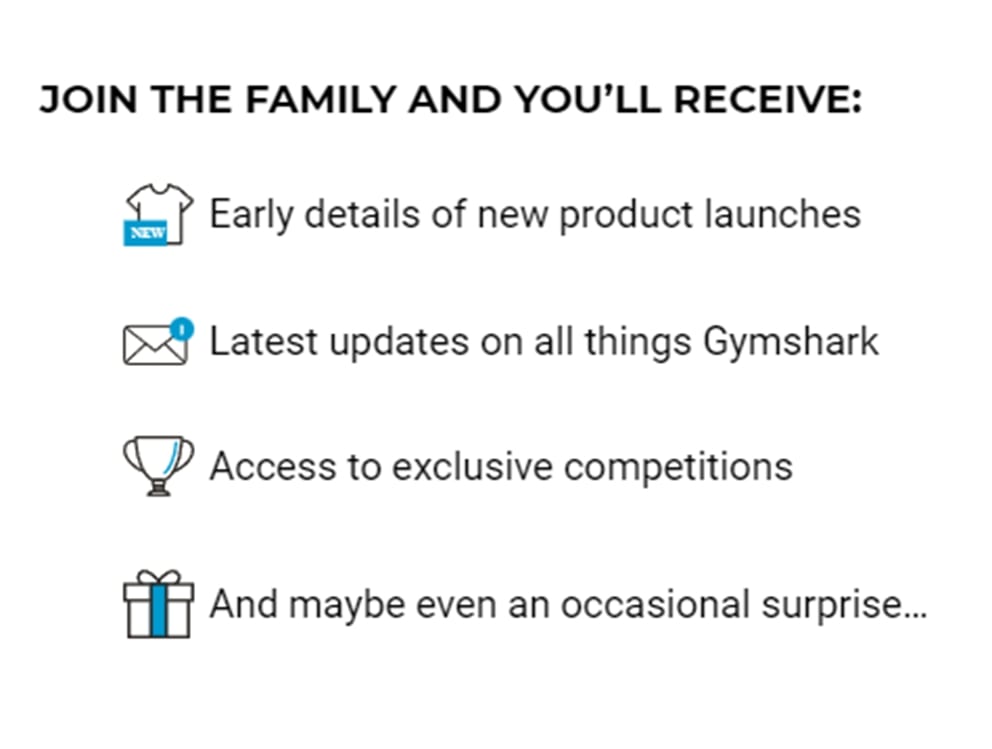
Loyalty programs are so widespread in ecommerce because they have immense benefits for brands.
Before the internet, customers were loyal to their local stores. They knew the staff, knew their way around, and had little choice but to shop there.
Today, thousands of options are available at every customer’s fingertips. A whole world of brands fights for their attention every day. These brands can undercut you on price or offer benefits you can’t to draw customers away.
What’s more, for smaller brands without a brick-and-mortar presence, customers today are more likely to simply forget about your brand. In the rush of advertisements and options and recommendations and influencer marketing, they can purchase something off your site, and even if they enjoy it, never return.
Loyalty programs work to prevent customer churn and increase lifetime value. They enable you to better understand your customers, build trust, create additional brand touchpoints, and keep them coming back for more.
We’ll start with the most obvious and important benefit of ecommerce loyalty programs: they encourage loyalty.
Loyal customers are your most valuable asset. They’re not only great shoppers who’ll stick with you in the face of competition—they’re also your biggest advocates:
- 65% of a company’s revenue comes from the repeat business of existing customers
- It’s 5-25x more expensive to acquire a new customer than to keep an existing one
- 77% of consumers say they’ve remained loyal to a specific brand for 10 years or more
- 57% of consumers spend more with brands they’re loyal to
- 74% of consumers say they’re more likely to recommend brands with good loyalty programs
The loyalty program strategy is specifically designed to help you reap the many benefits of loyal customers. It empowers you to facilitate loyalty among new customers, and nurture and reward loyalty among existing ones.
Loyalty programs are an answer to the ease with which customers can switch brands in the internet age. They facilitate a deeper connection with customers, enabling you to inspire trust, gamify shopping, and keep your brand top-of-mind.
78% of consumers say loyalty programs make them more likely to do business with a brand. And an additional 72% say that such programs are part of their relationships with brands.
RELATED: Customer Loyalty in Ecommerce: The Surprising Benefits of Fairness
The aim of your loyalty program should be to ensure that when your customers need new sneakers, groceries, swimwear—whatever it is you sell—they think only of you. This is the power of Amazon Prime. With its strong focus on customer experience, and free and incredibly fast shipping, millions of customers look to Amazon before anywhere else when purchasing an item.
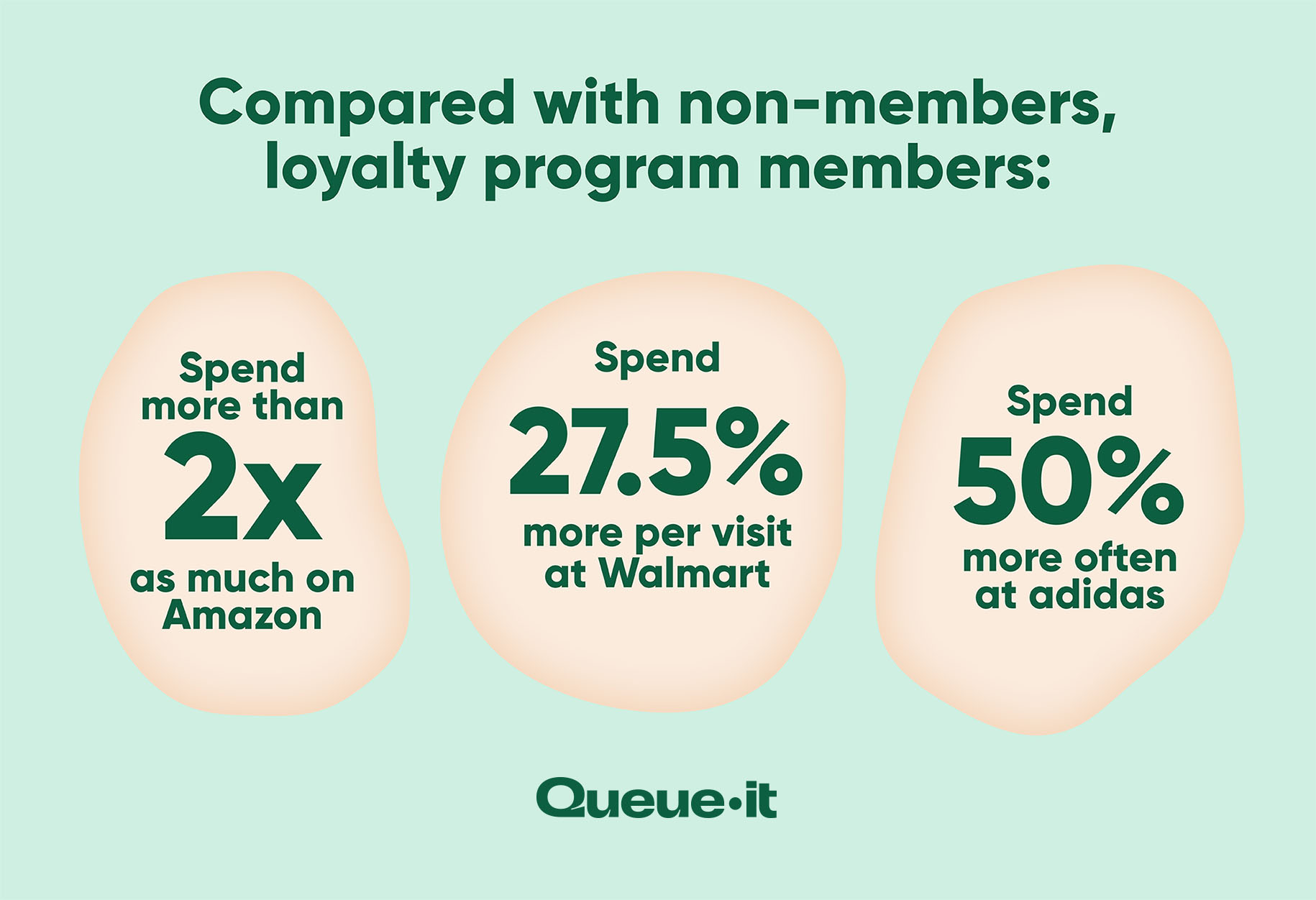
The next key advantage of loyalty programs is capturing owned media.
In a competitive ecommerce environment, owned media like email, apps, and social media, are among the most cost-effective and important marketing channels for online retailers. Email marketing, for example, drives a $36 ROI for every $1 spent.
Every single ecommerce loyalty program involves collecting email addresses. And many more involve downloading apps.
Now, you might ask: what’s the difference between a loyalty program and a newsletter? Why bother with all these extras if it’s just about gathering email addresses?
The key difference between a loyalty program and a traditional newsletter comes in the contents of your emails.
Customers don’t want to be contacted daily with random product suggestions, brand news, and sales notifications. Email fatigue is real. Only 14% of email subscribers feel that more than half the emails they receive are useful to them.
Sending out too many reminders about your brand will lead customers to ignore your brand comms, or worse, unsubscribe.
RELATED: 23 Best Practices to Send Effective Ecommerce Email Newsletters
Loyalty programs work to prevent this by offering exclusive benefits and by personalizing brand communications.
Gymshark’s email sign-up CTA, for instance, reads: “Want emails you’ll actually read? Sign up for exclusive deals, our latest drops, and more!”
Customers sign up to loyalty programs for exclusive discount codes, early access to sales and product drops, gifts on their birthdays, and other rewards. When the emails and app notifications they get from your brand are presents and discounts—things customers want—they’re less likely to unsubscribe.
Additionally, where newsletters will typically only request an email address, loyalty programs will request things like your date of birth, name, and product interests. Advanced loyalty programs will use this data, along with purchase history, to segment and personalize communications.
With a successful loyalty program, you get an extensive list of customers with some level of purchase intent established. This means when your team launches a new sale, or drops a new product, or kicks off a new campaign, you have a curated audience to whom you can display the material at little-to-no cost.
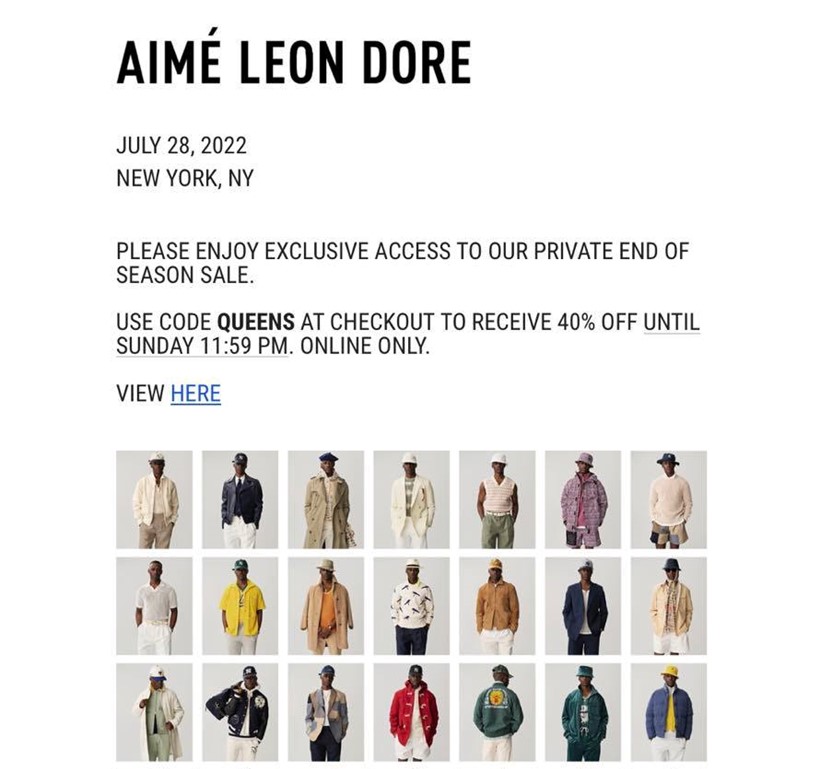
As tech companies like Google and Apple and government regulators focus increasingly on privacy, retailers’ access to customer data is shrinking. Cookies are dying, and regulation like GDPR, CCPA, and IDFA are quickly making third-party data a thing of the past.
Loyalty programs help retailers counteract this data depreciation. They enable brands to capture zero-party data, meaning information willingly provided to a company.
Think with Google reports more than half of U.S. consumers are comfortable sharing their information so long as they get value in return. People get value from this exchange if it:
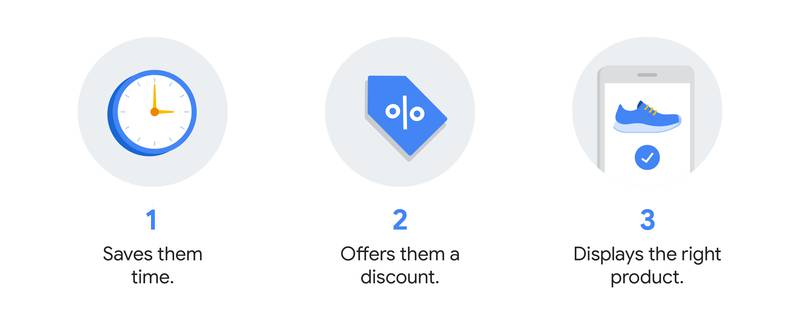
This is what the best ecommerce loyalty programs do. They encourage customers to share zero-party data in exchange for convenience, personalization, and other exclusive benefits.
To put this into concrete terms, consider the Starbucks Rewards program and the value given to customers in exchange for data:
- Free coffee on your birthday gives Starbucks your age and date of birth
- Benefits after repeat orders gives Starbucks your order frequency
- Save your favorite order for fast-ordering gives Starbucks your preferences
- Offers at your local store gives Starbucks your proximate location
- Recommend a friend lets Starbucks track word-of-mouth marketing (n.b. this is not an actual feature of Starbucks Rewards)
- Member-only games provide additional data insights
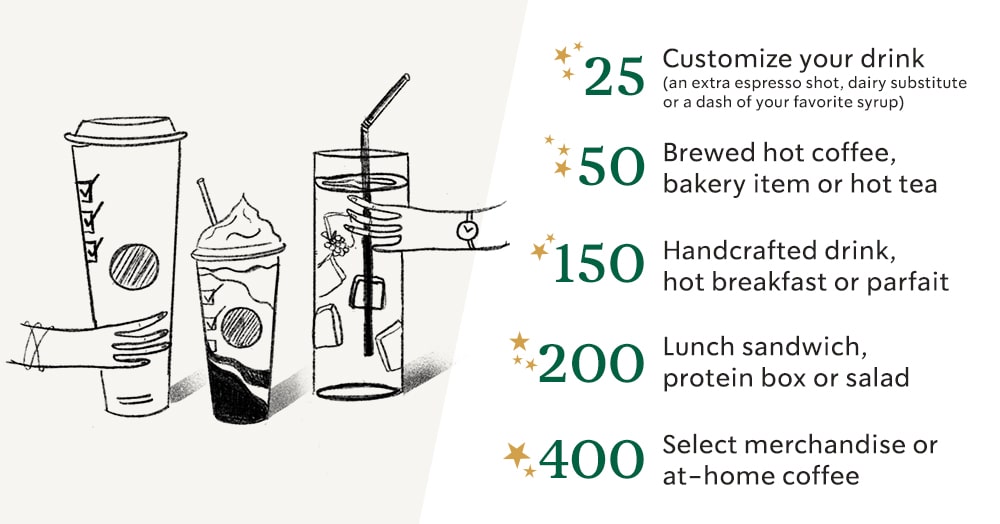
Zero-party data is also more valuable than third-party data because it doesn’t break down trust.
Customers who volunteer their information aren’t freaked out when they see it used. They aren’t scared and suspicious like when they see ads on Facebook based on a Google search or a purchase they made at the supermarket. They don’t imagine their devices are listening to them and your brand is exploiting them.
Loyalty programs create a voluntary, mutually beneficial exchange of value—you get your data, customers get their perks.
That’s why when Nike launched its direct-to-consumer (DTC) strategy, it not only created a membership program and apps with exclusive perks, it also acquired data analytics companies Datalogue, Zodiac, Invertex, and Celect.
These acquisitions and Nike’s DTC strategy create a positive feedback loop in which DTC sales gives them more data, with which they can better understand customers and improve their strategy, with which they get more data.
RELATED: Boost Your Ecommerce Customer Experience with These 9 CX Tips & Tricks
Zero-party data helps not only with understanding your customers and personalizing their experience, but it can also help with inventory planning, product development, and scaling your site to prepare for major sales or product drops.
Loyalty programs are a relationship. And like any relationship, relationships between customers and brands don’t come without work, trust, and reciprocity.
72% of customers consider loyalty programs part of their relationship with brands.
6 out of 10 consumers in loyalty programs have more positive experiences with brands because they believe their connection transcends the transactional.
For this reason, Bond’s leading annual report on loyalty programs focuses not just on concrete benefits and outcomes of loyalty programs, but also on the impact of things like reciprocity, brand values, and trust.
Bond differentiates brands that focus on these soft benefits from brands that don’t by calling them “loyalty brands”.
A loyalty brand is one that’s focused not only on capturing loyalty from customers, but one that’s focused on being loyal to customers. This means being committed to customers’ values and delivering a superior customer experience.
Customers want loyalty programs that provide experiential benefits such as trust, community, and reciprocity, as well as tangible benefits like discounts, free shipping, and exclusive access.
In this section, we’ll look at the stats and data behind both to uncover what exactly customers want from a loyalty program, and what keeps them loyal to a brand.
Loyalty is built not only through benefits—it’s built through trust.
That’s why a Deloitte survey found 83% of consumers reported trustworthiness being the emotional factor that’s most aligned with their favorite brands. And an Accenture survey found trustworthiness to be the most influential factor driving loyalty.
Bond’s concept of brands that are loyal to customers (loyalty brands) is key to inspiring trust in both loyalty programs and the brands behind them. Bond reports the three most important drivers of this are:
- Knowing and understanding customers
- Providing great customer service
- Making members feel like part of a community
Experiential benefits like these are what create “loyalty brands.” And such brands boost customers’ average monthly spend by $26.
Crucial to all three of these points is being aligned with your customers’ values and delivering a fair and reliable online experience.
When a brand is aligned with a customer’s values, that customer is:
- 3.4x as likely to recommend your brand
- 9.8x as likely to go out of their way to do business with your brand
- 9.9x as likely to spend more with your brand

We’ll dive deeper into alignment with customer values in the next section on examples of successful loyalty programs. But when devising your loyalty program, you should keep in mind what your customers want and what they stand for. Do they love your brand because it’s sustainable? Inclusive? Convenient? Cheap? Community-focused?
Nike and adidas’ loyalty programs, for example, focus on fitness and fashion with exclusive product drops and access to fitness apps. Amazon Prime focuses on convenience and great deals. Samsung Members focuses on community, tech tips, and customer service.
Establish what your customers love about your brand, and ensure those values shine through in your loyalty program.
The next crucial experiential benefit is providing a fair and reliable online experience.
Researchers have found fairness plays a crucial role in establishing trust and loyalty in ecommerce. Customer perceptions of fairness account for:
- 80% of the variance in trust in online retailers
- 71% of the variance in customer satisfaction
- 56% of the variance in customer loyalty
Bond’s 2022 Loyalty Report explains some of the most important factors for being seen as a loyal and trustworthy brand are:
“How an organization cares for the planet, ensures the fair treatment of people, and fosters integrity and fairness within the organization.”
Fair treatment of customers, employees, and the planet, will shine through and establish satisfaction, trust, and loyalty among customers.
You can learn more about using fairness to inspire loyalty in our blog Customer loyalty in ecommerce: the surprising benefits of fairness.
Additionally, if you want to learn 9 strategies to elevate your ecommerce customer experience, check out Boost your ecommerce customer experience with these 9 CX tips & tricks.
While building trust and delivering a superior loyalty program experience are crucial to keeping customers coming back for more, they’re rarely enough to draw customers into a program. The fact is, customers need the value of your loyalty program shown to them in easy to understand, tangible ways.
Surveys show the top priorities for customers in joining ecommerce loyalty programs are:
- Discounts & deals
- Additional benefits (free shipping, content access, etc.)
- Points-based reward systems
- Early access to products/experiences
- Exclusive access to products/experiences
You’ll find these benefits across almost all loyalty programs. But of the 5 listed, it’s only the last two that enable you to capture loyalty at little-to-no additional cost.
You see, every online retailer offering a loyalty program faces one key question: how do we make customers feel a membership is worth their money without sacrificing our own?
RELATED: How to Use Scarcity Marketing & Product Drops for Black Friday Success
Where there’s an abundance of consumer choice, many companies turn to steep discounts and special offers to generate brand relationships.
But you have another tool at your disposal: exclusivity.
Exclusivity is a powerful resource.
It lets you offer customers unique benefits without sacrificing total revenue. This exclusivity play is made across just about every retail loyalty program you can think of—from Walmart to Nike to Amazon to Sephora.
It simply involves granting members of your loyalty program exclusive first access to sales, product drops, and restocks.
After expensive benefits like free shipping and discounts, exclusivity in the form of early access are customers two biggest desires for loyalty programs. 60% of shoppers want early access to sales, and 51% want early access to new products.

Source: Yotpo State of Brand Loyalty Global Consumer Survey 2021
But early access or invite-only sales can be difficult to get right. Often companies will simply email out a link to a private sale page that quickly gets shared around and exploited by bots and resellers.
Loyal customers who follow the link just an hour after it’s sent find products sold out and question just how exclusive their “exclusive access” really is.
To avoid this problem, many retailers use exclusive access solutions like an invite-only waiting room. With an invite-only waiting room, you can control access to exclusive sales to engage loyal customers, block bots, and incentivize loyalty program sign-ups. You can do this by gating access with unique user identifiers (such as an email address), which can only be used by the email address holder and can only be activated once.
The invite-only waiting room ensures early and exclusive access sales are truly exclusive to only the customers you choose, giving you the control you need to reward your loyal customers with confidence.
RELATED: Roll Out the Red Carpet for Loyal Customers with Exclusive Invite-only Sales & Drops
Walmart+ is Walmart’s answer to Amazon Prime. It’s a subscription-based loyalty program with a price tag of $12.95 per month or $98 per year.
Walmart+ makes a big claim on its sign-up page: It’ll save you $1,300+ per year.
The claim aligns perfectly with Walmart’s brand positioning—a low-price retailer—and the values of its customers—saving money. It establishes the program’s value in bold and concrete terms by screaming “you’re leaving money on the table by not signing up!”
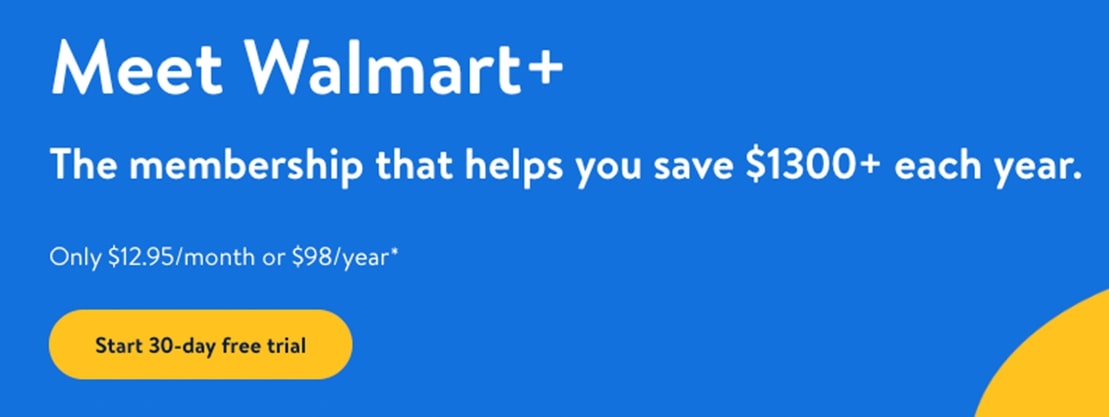
With Walmart+, customers:
- Save up to 10 cents per gallon at several gas stations
- Get free delivery of groceries from their local Walmart store and free delivery from the Walmart marketplace
- Get early access to Black Friday sales, product launches, and other major shopping events
- Get contact-free checkout
- Get assorted other benefits, for example, 6 months free of Spotify premium
These benefits are focused on two areas Walmart is already known for: convenience and value.
Additionally, Walmart’s early access sales leverage the massive demand surrounding their Black Friday deals and product drops to capture sign-ups during the peak shopping season.
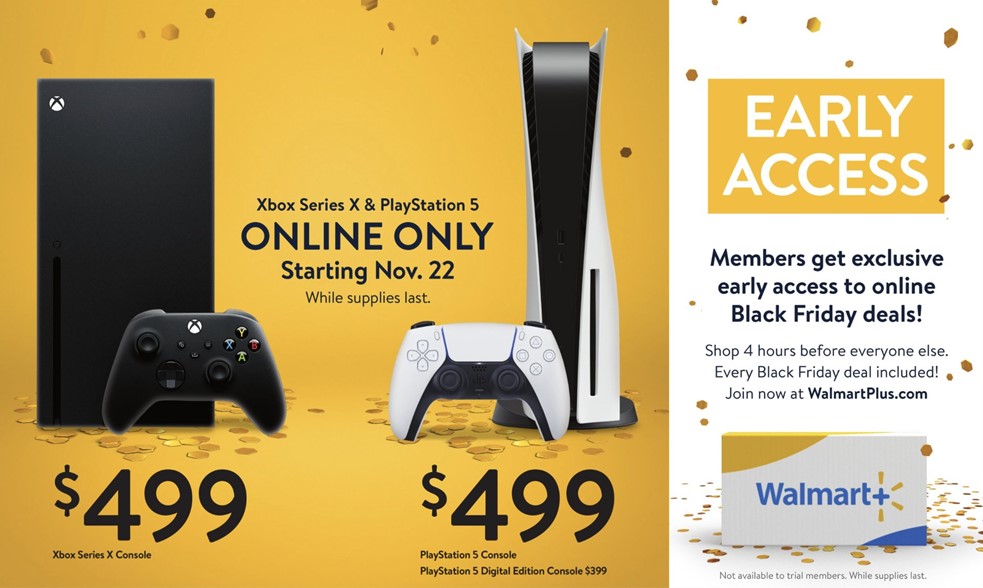
A Consumer Intelligence Research Partners report estimates:
- Walmart+ members spend an average of $79 per online visit, compared to $62 for non-members.
- Walmart+ customers shopped an average of 11 more times per year (29 visits) compared with non-members (18).
Luxury ecommerce retailer FARFETCH has an extensive loyalty and rewards program called FARFETCH ACCESS. Like an airline, it offers a broad range of benefits based on tiers, which are determined by customer spend. These tiers include:
- Bronze access, which is achieved after one purchase, entitles you to a welcome reward, a birthday reward, and access to a private members’ sale.
- Two tiers up is Gold access, which is achieved after a $3,000 annual spend. Gold Access members get the same benefits as Bronze, along with exclusive additional discounts and free worldwide shipping on 4 orders.
- At the top of the Access tiers is Private Client access, which is reached after a $15,000 annual spend on FARFETCH. Private client access gives you all the Gold access benefits, plus unlimited free worldwide shipping, exclusive product access, priority customer care, extended returns periods, a fashion concierge, and an around the clock personal stylist.

FARFETCH’s loyalty program aligns with its customer base and brand values. Where Walmart customers are focused on low prices, FARFETCH customers want luxury and exclusivity. Of particular note is the Private Client access tier, which is clearly targeted at the upper echelons of the fashion world, offering extensive and desirable benefits to the most valuable of customers.
AdiClub has been one of adidas’ biggest strategic moves in recent years. It’s an extensive, points-based rewards program that’s helping drive their DTC shift. AdiClub received the top ranking in the apparel category in Bond’s Loyalty Report in both 2021 and 2022.
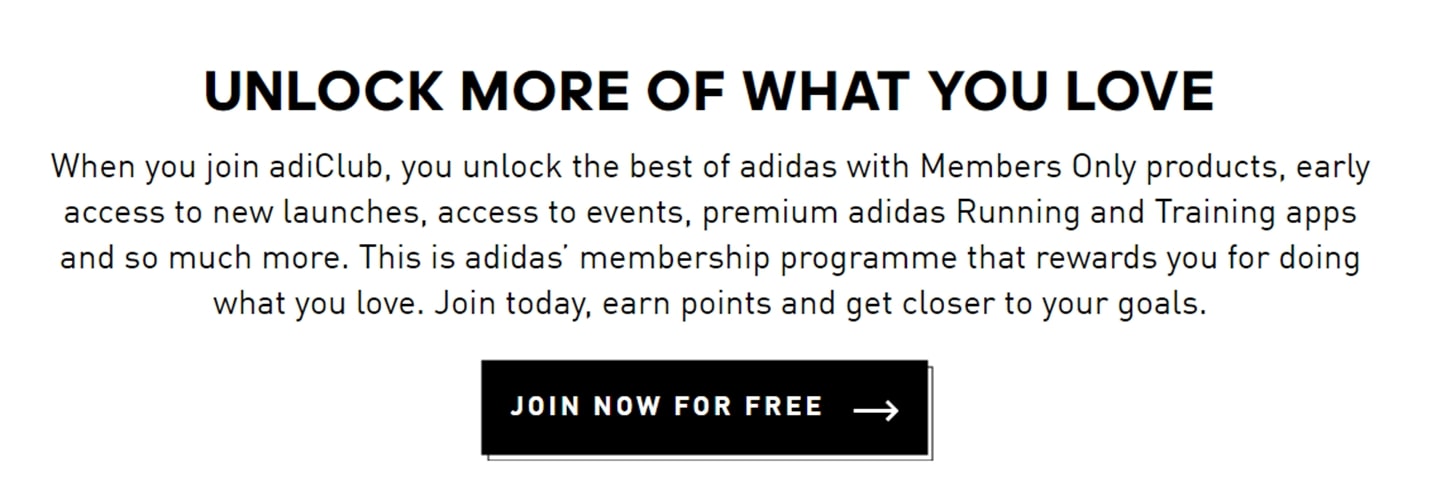
Members of adidas’ adiClub receive points for purchases (10 points for every dollar spent) as well as adding personal information and reviews and taking part in adidas events. These points not only work to move customers up a tier in the membership but can also be used for discounts and vouchers. adiClub involves 4 levels:
- At level 1, customers get free shipping, members-only access to exclusive releases, access to the CONFIRMED app for sneaker drops and Early Access to select drops.
- At level 2, customers get the above benefits plus special discounts, 2 months access to the adidas Running and Training apps, and a birthday gift.
- At level 3, customers get first access to new products, the ability to personalize products, and priority customer service.
- Level 4 customers get all the above rewards, plus tickets to special events, priority access on the CONFIRMED app to win more drops, and 12 months premium access to adidas running and training apps. To get to level 4, you need to spend about $1,200 on adidas goods over the course of a year.
Adidas additionally infuses their membership program with other attractive benefits, such as chances to win adidas box seats at sporting games, products signed by some of the world’s biggest athletes, and a member’s week full of product drops, experiences, and rewards.

AdiClub is hugely successful because it ties it focuses in on two core elements of the brand: sport and fashion. Customers are encouraged to level up to achieve increasing levels of exclusive access, and other key benefits tie back to engagement via sports and sports-related benefits. AdiClub also focuses on community-based events.
There are thousands of ecommerce loyalty programs across we could dive into across industries. Here’s 10 of our favorites:
- Nissan Switch: A $700 per month subscription that lets you switch cars daily.
- Gillette on Demand: A razorblade subscription service—Gillette’s answer to Dollar Shave Club.
- On Running: A sustainable running shoe subscription enabling you to swap out your shoes every 6 months.
- Beauty Insider by Sephora: A points-based system giving access to new rewards twice each week.
- Nike membership: A free membership enabling customers to shop exclusive drops, customize shoes, and access Nike exercise apps.
- Amazon Prime: The world’s biggest subscription service, granting free same-day delivery, early access shopping, exclusive Prime member deals, and access to services like Prime Video, Music Prime, Prime Reading, and Prime Gaming.
- Costco: A membership-based shop for bulk household staples at significant discounts.
- The Home Depot Pro Xtra Loyalty Program: Access to exclusive benefits, discounts, and point-based rewards at The Home Depot.
- Lululemon’s Sweat Collective: In a small-scale version of influencer marketing, Lululemon’s membership program and its benefits are only available to “leaders in sweat”, meaning personal trainers, class instructors, professional athletes, gym owners and managers, and coaches.
- Samsung members: a free community-based membership enabling customers to unlock exclusive content, share their experiences, discuss Samsung products, and get special offers.
Loyalty programs have taken over retail for a reason: they increase the lifetime value of customers and boost brand affinity.
But loyalty programs aren’t a set-and-forget strategy. They’re a relationship between your brand and your customers.
The three key types of ecommerce loyalty programs are:
- Subscriptions
- Rewards programs
- Membership
You’ll need to carefully consider type of program is right for your brand and which will deliver your customers the most value.
Loyalty programs will offer you a range of benefits, but the three most powerful are:
- Capturing & nurturing loyalty
- Getting owned media
- Gathering zero-party data to better understand customers
You can only expect to achieve these benefits if your loyalty program offers both experiential and tangible benefits. The experiential benefits include:
- Alignment with customer values
- Sense of community
- Superior customer service
- Fairness & trustworthiness
And the tangible benefits you need to attract customers include:
- Discounts & deals
- Benefits (free shipping, service fee waived, etc.)
- Points-based reward systems
- Early access to products/experiences
- Exclusive access to products/experiences
Of these tangible benefits, the most cost-effective are those that leverage exclusivity and personalization to make customers feel special. Running private sales, granting members first access to product drops, and giving members early access to Black Friday deals are among the simplest, cheapest, and most effective methods for attracting and nurturing loyalty.
To discover how you can run exclusive events fairly and securely, check out our invite-only waiting room.
(This blog has been updated since it was written in 2022).